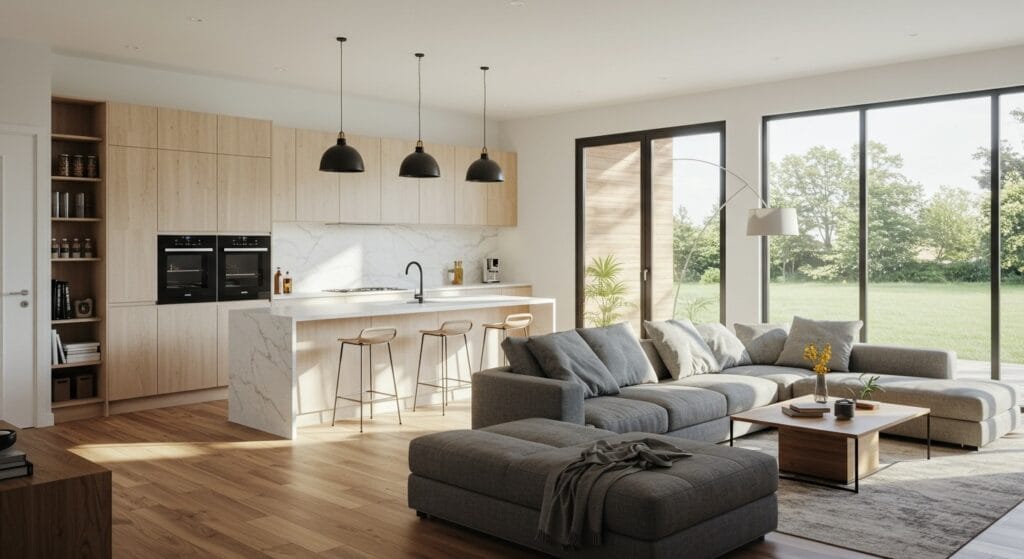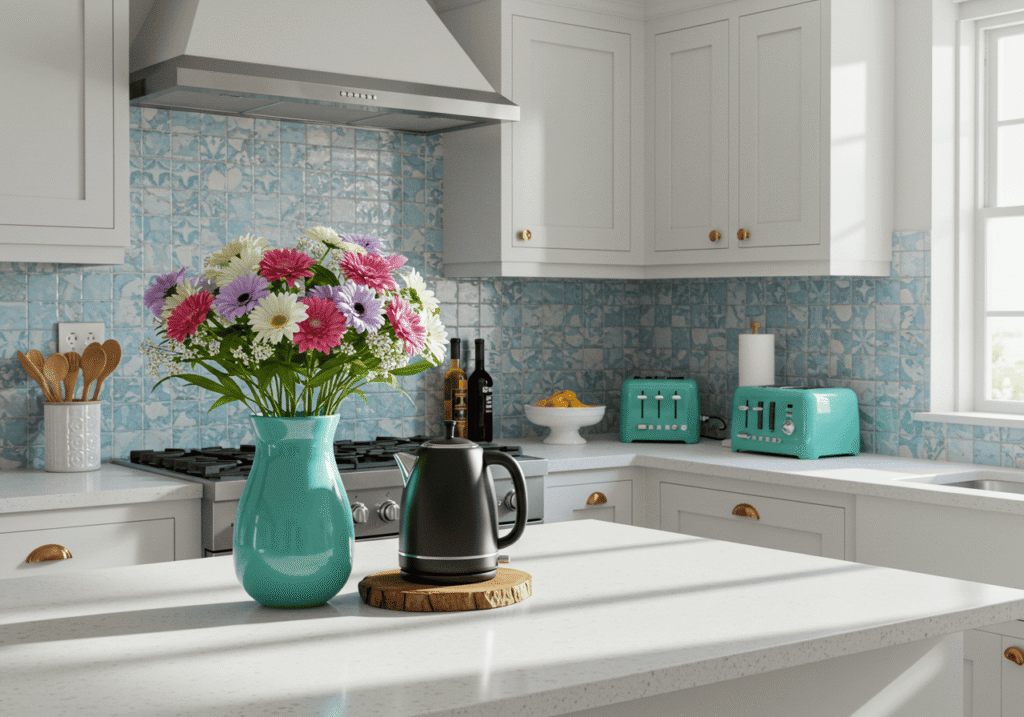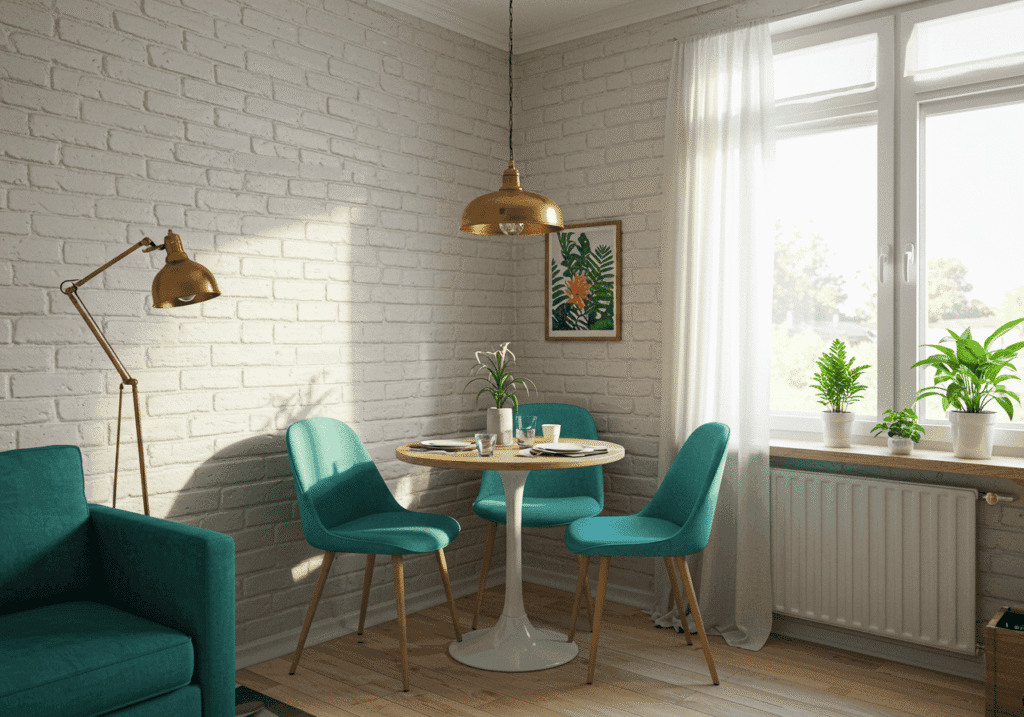There’s something magical about walking into a home where the kitchen flows effortlessly into the living room. No walls blocking conversation, no barriers preventing you from chatting with guests while you prep dinner, and definitely no feeling cramped in separate, tiny rooms.
The kitchen living room open concept has become the heart of modern home design for good reason. It creates space that feels larger, brighter, and infinitely more welcoming. But here’s what I’ve learned after seeing countless open floor plan kitchen designs – not all of them work seamlessly.
The trick isn’t just knocking down walls (though that’s often part of it). Creating the perfect open concept design requires thoughtful planning, smart furniture placement, and a few design secrets that make the difference between a space that flows beautifully and one that feels chaotic.
Understanding the Magic Behind Open Floor Plan Kitchens
Open concept living transforms how we experience our homes. Instead of cooking in isolation, you become part of every conversation, every movie night, every homework session happening in the living room.
The beauty lies in the seamless transition between spaces. Your kitchen island becomes a natural gathering spot where kids do homework while you prepare dinner. The living room sofa faces both the TV and the kitchen, so no one misses out on family time.
What makes this layout so appealing goes beyond just aesthetics. Natural light flows freely throughout the entire space, making both areas feel brighter and more spacious. You’re also maximizing every square foot – something particularly valuable in today’s homes where space comes at a premium.
But I’ll be honest, this design approach isn’t without its challenges. Cooking smells travel directly into your living space. Kitchen clutter becomes instantly visible to anyone relaxing on the sofa. Sound carries differently, which means your morning coffee routine might wake sleeping family members.
Planning Your Open Concept Layout Like a Pro
The foundation of any successful open concept design starts with understanding traffic flow. People need clear pathways between the kitchen work triangle and the living room seating area without bumping into furniture or appliances.
I always recommend mapping out your daily routines first. Where do you naturally walk when you come home with groceries? How do family members move between the kitchen and living room during busy mornings? These patterns should guide your furniture placement decisions.
Your kitchen island placement becomes crucial in this setup. It should provide workspace and storage while creating a natural boundary between cooking and relaxing zones. Position it so someone sitting at the island can easily join conversations happening on the living room sofa.
Consider sight lines carefully too. You want visual connection between spaces, but you also need strategic ways to hide kitchen messes when entertaining. A slightly raised island or decorative room divider can provide just enough separation without blocking the open feel.
The key is creating distinct zones that still feel connected. Think of it as designing one large room with different purposes rather than trying to combine two separate rooms.
Creating Seamless Living Spaces Through Color and Materials
Color coordination becomes your best friend in open concept spaces. The palette you choose for your kitchen cabinets needs to complement your living room furniture, but that doesn’t mean everything has to match perfectly.
I love using a consistent neutral base throughout both areas – think warm whites, soft grays, or warm beiges on walls and larger furniture pieces. Then layer in personality through accent colors that appear in both spaces. Maybe it’s navy blue bar stools that echo the throw pillows on your living room sofa.
Flooring plays a huge role in creating visual flow. Hardwood floors that run continuously from kitchen to living room instantly make the space feel larger and more connected. If budget constraints mean mixing materials, choose options that complement each other in tone and style.
Lighting deserves special attention in seamless living spaces. You need task lighting for kitchen work, ambient lighting for living room relaxation, and accent lighting to highlight beautiful features. Pendant lights over the island can echo the style of your living room table lamps, creating visual rhythm throughout the space.
Don’t forget about texture and materials. Natural wood cutting boards in the kitchen might mirror the wood coffee table in the living room. Stone countertops could complement a stone accent wall behind the TV.
Smart Furniture Placement for Maximum Flow
Your furniture arrangement can make or break an open floor plan kitchen design. The goal is creating conversation areas that don’t interfere with kitchen workflow while maintaining that coveted open feeling.
Start with your largest pieces – the kitchen island and living room sofa. These anchor points determine how the rest of your space will function. Your sofa should face toward the kitchen enough for easy conversation but not so much that TV viewing becomes awkward.
Kitchen islands work best when they’re substantial enough to provide good workspace but not so large they dominate the entire area. I typically recommend leaving at least 42 inches of clearance around all sides for comfortable movement.
Bar seating at your island creates a natural transition between spaces. Choose stools that can tuck completely under the counter when not in use – this keeps walkways clear and maintains clean sight lines.
Consider floating your living room furniture slightly away from walls. A sofa positioned to create a conversation area with the kitchen island feels more intentional than one pushed against the back wall. Add a console table behind the sofa for extra surface space and visual weight.
Storage becomes trickier in open concept layouts since everything is visible. Look for storage solutions that serve both spaces – like a beautiful cabinet that holds dishes and also displays books or decorative objects.
Defining Zones Without Losing the Open Feel
Even in the most open layouts, you need some way to distinguish between cooking and lounging areas. The trick is creating subtle boundaries that define space without blocking views or interrupting flow.
A kitchen island naturally creates separation while maintaining connection. But you can also use furniture placement, lighting changes, or even ceiling details to suggest different zones without adding walls.
Area rugs work beautifully for this purpose. A large rug under your living room seating area immediately defines that space as separate from the kitchen zone. Choose something substantial enough to anchor all your furniture – ideally, all sofa and chair legs should sit on the rug.
Ceiling treatments can subtly define areas too. Maybe your kitchen has recessed lighting while your living room features a statement chandelier or pendant lights. Different ceiling heights, if your home allows for it, create natural zone separation.
Built-in elements like a partial wall with open shelving or a two-sided fireplace can provide separation while maintaining visual connection. These architectural features give each space its own identity without sacrificing the open concept benefits.
Consider using different materials or finishes to define zones. Your kitchen might feature sleek quartz countertops while your living area showcases a rustic wood coffee table. These material contrasts help distinguish spaces while maintaining overall design harmony.
Lighting Solutions That Enhance Both Spaces
Lighting in open concept spaces requires layering different types throughout the entire area. You need bright task lighting for food preparation, ambient lighting for entertaining, and accent lighting to create mood and highlight beautiful features.
Start with your kitchen island – this is where pendant lights really shine. Choose fixtures that provide good task lighting while adding style that complements your living room decor. The scale should be substantial enough to anchor the island without overwhelming the space.
Under-cabinet lighting in the kitchen ensures good workspace illumination while adding a lovely glow that extends into the living area. LED strips hidden under cabinets create clean lines and eliminate harsh shadows on countertops.
Your living room needs its own lighting personality. Table lamps provide intimate ambient lighting for reading or conversation. A statement chandelier or pendant light can create a focal point that balances the kitchen’s pendant lights.
Don’t forget about natural light – it’s your secret weapon in open concept design. Remove heavy window treatments that block light flow between spaces. Instead, choose options that can be opened completely during the day while providing privacy when needed.
Dimmer switches become essential in open concept layouts. You want the flexibility to bright kitchen lighting during meal prep while keeping living room lighting soft for movie nights.
Storage Solutions for Open Concept Living
Storage challenges multiply in open concept spaces because everything is visible all the time. Kitchen clutter can’t hide behind closed doors, and living room messes are immediately apparent from the cooking area.
Smart kitchen storage starts with maximizing vertical space. Tall cabinets that reach the ceiling provide more storage while drawing the eye upward, making ceilings appear higher. Open shelving can look beautiful if you’re committed to keeping it organized and styled.
Your kitchen island should work overtime as a storage powerhouse. Include deep drawers for pots and pans, shallow drawers for utensils, and maybe even a wine fridge or microwave to keep countertops clear.
Living room storage needs to coordinate with kitchen design while serving its own purpose. A media console that matches your kitchen cabinetry creates visual continuity. Ottoman storage provides extra seating while hiding throw blankets and games.
Consider furniture that serves double duty. A kitchen table that can function as additional prep space when needed. A living room coffee table with hidden storage for remotes and magazines.
Built-in solutions often work best in open concept spaces because they can be designed to serve both areas while maintaining clean sight lines.
Color Schemes That Work Across Both Areas
Choosing colors for open concept spaces requires thinking about how different shades interact across a large area. You want enough variety to keep things interesting while maintaining harmony that ties everything together.
Neutral foundations work best – think warm whites, soft grays, or gentle beiges on walls and larger furniture pieces. These colors provide a calm backdrop that makes the space feel larger and brighter while giving you flexibility with accent colors.
Layer in personality through accent colors that appear in both spaces. Maybe your kitchen backsplash features subtle blue tiles that echo the throw pillows on your living room sofa. Or warm brass hardware in the kitchen coordinates with brass table lamps in the living area.
Wood tones should coordinate throughout the space. If your kitchen features warm walnut cabinets, your living room coffee table should complement that warmth rather than fighting against it with cool-toned wood.
Don’t be afraid to use different shades of the same color family. Your kitchen island might be painted in a darker gray while your living room walls stay light gray. This creates depth and interest while maintaining color harmony.
Metallic finishes should coordinate too. Stick with either warm metals (brass, bronze, gold) or cool metals (chrome, nickel, black) throughout both spaces for the most cohesive look.
Dealing with Common Open Concept Challenges
Every open concept design comes with its own set of challenges, but knowing what to expect helps you plan solutions from the beginning.
Cooking smells and sounds are probably the biggest concern. A high-quality range hood is essential – choose one powerful enough to handle your cooking style without being so loud it drowns out conversation. Position it strategically to pull odors away from living areas.
Kitchen clutter becomes instantly visible to anyone in the living room. This means staying on top of daily cleanup becomes more important than ever. Design adequate storage so everything has a designated place, and develop habits that keep countertops clear.
Sound control requires strategic planning. Hard surfaces like tile and hardwood floors can make spaces feel echo-y. Add soft furnishings in the living area – rugs, curtains, throw pillows – to absorb sound and create a more comfortable acoustic environment.
Temperature control can be tricky in large, open spaces. Ceiling fans help circulate air, and area rugs can make hard floors feel warmer. Consider your HVAC system’s capacity when planning major open concept renovations.
Privacy sometimes becomes an issue when cooking areas are always visible to guests. Strategic furniture placement or decorative screens can provide some separation when needed without permanently blocking the open feel.
Small Space Open Concept Solutions
Open concept design can work beautifully in smaller homes too – you just need to be more strategic about every square foot.
In compact spaces, your kitchen island might need to serve triple duty as prep space, dining table, and storage solution. Choose a design that’s proportional to your space – too large and it will overwhelm the room.
Vertical storage becomes even more critical in smaller open concept layouts. Take advantage of wall space in both kitchen and living areas. Floating shelves can display dishes in the kitchen and books in the living room while keeping floor space open.
Furniture scale matters enormously in compact open concept spaces. Choose pieces that serve multiple purposes – like a dining table that doubles as workspace or a coffee table with hidden storage.
Light colors and minimal patterns help small open concept spaces feel larger. Too many busy patterns or dark colors can make the space feel cramped despite the open layout.
For more ideas on making the most of limited square footage, check out these small living room tips that work perfectly in open concept designs.
Budget-Friendly Open Concept Updates
Creating your dream open concept space doesn’t have to break the bank. Some of the most impactful changes cost surprisingly little when you know where to focus your efforts.
Paint might be your biggest bang for the buck. A consistent color palette throughout kitchen and living areas instantly creates visual flow. Choose colors that make both spaces feel larger and brighter – warm whites and soft grays typically work best.
Lighting updates can dramatically change how your space feels. Swapping out old fixtures for coordinated pieces throughout both areas creates instant style. Look for sales on pendant lights for your kitchen island and matching table lamps for the living room.
Window treatments that span both areas help create unity without major renovation. Choose styles that can open completely to maximize natural light flow between spaces.
Decorative accessories that coordinate between kitchen and living areas tie the spaces together visually. Maybe matching vases on your kitchen counter and living room side table, or coordinated artwork that appears in both spaces.
For more budget-conscious renovation ideas, these DIY budget kitchen renovation tips can help stretch your decorating dollars further.
Styling Tips for Instagram-Worthy Results
The styling details make the difference between a functional open concept space and one that’s truly magazine-worthy. Focus on creating vignettes that look beautiful from multiple angles since your space is visible from everywhere.
Your kitchen island styling should be both functional and beautiful. A wooden cutting board, a small potted herb garden, and maybe a beautiful bowl of fruit create an inviting scene that doesn’t interfere with daily use.
Living room styling should coordinate with kitchen elements while serving its own purpose. If your kitchen features natural wood accents, echo that warmth with a wood coffee table or decorative bowls in the living area.
Fresh flowers or greenery can bridge both spaces beautifully. A large arrangement on your kitchen island might coordinate with smaller plants on your living room side tables.
Textiles add warmth and personality to open concept spaces. Kitchen window treatments should coordinate with living room throw pillows or rugs. This creates visual rhythm that ties the spaces together naturally.
Don’t forget about the view from every angle. Your space will be photographed and admired from multiple directions, so style accordingly.
Maintenance and Organization Strategies
Keeping an open concept space looking its best requires developing smart daily habits since everything is always on display.
Kitchen organization becomes more critical when your cooking space is visible to guests. Invest in beautiful storage containers that look good on open shelves. Keep countertops as clear as possible by having designated spots for everything you use regularly.
Living room tidiness affects how your entire space feels. Develop systems for managing remote controls, magazines, and everyday items that tend to accumulate on coffee tables. Beautiful storage baskets can hide clutter while adding texture to your decor.
Daily cleaning routines help prevent the overwhelming feeling that can come with large, open spaces. A few minutes each evening to reset both kitchen and living areas keeps everything looking intentional rather than chaotic.
Seasonal styling updates keep your space feeling fresh. Swap throw pillows, change out accessories, or add seasonal flowers to give both areas a coordinated refresh.
Creating Your Dream Open Concept Space
Designing the perfect kitchen living room open concept requires balancing function with beauty, storage with style, and connection with defined spaces. The most successful designs feel effortless – like the spaces were always meant to flow together.
Remember that your open concept space should reflect how your family actually lives. If you’re entertainers who love hosting dinner parties, focus on creating multiple conversation areas. If you’re a busy family always on the go, prioritize easy maintenance and smart storage solutions.
The beauty of open concept living lies in its flexibility. Your space can adapt to whatever life throws at it – from quiet Sunday morning coffee to holiday gatherings with extended family.
Take time to live in your space before making major furniture or decor decisions. You’ll discover natural traffic patterns and understand how your family uses the space, which will guide you toward the best solutions.
For more inspiration on creating beautiful, functional living spaces, explore our collection of living room ideas and kitchen and dining ideas that work perfectly in open concept layouts.
Your perfect kitchen living room open concept is waiting – and with these strategies, you’re ready to create a space that’s both beautiful and brilliantly functional.


